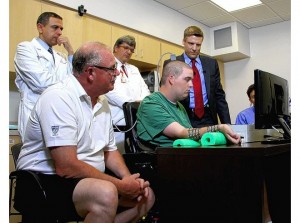

After Neurobridge, Burkhart can move his paralyzed arm. Burkhart became the first of five participants to test the technology, which has been in development for nearly a decade, in clinical development. Although he understood there were no guarantees of the experiment improving his life, his love for science and positive attitude made him eager to participate. Able-bodied people can control body parts with their mind. Functions within the spinal cord allow for harnessing and translating of signals from brain to muscle. Although it seems absolutely normal to do so, considering this is the way our mind communicates to make our body parts move, Burkhart is the first man in the world to move his hand with the power of his thoughts.
A pea-sized microchip placed in his brain “works to decode algorithms from the brain, and create a bypass around the spinal cord to his arm and a sleeve that provides electrical stimulation to make muscles move”. Chips have been placed in the brain before to manipulate a robotic arm for example, but it isn't believed that anyone has linked a chip and the brain directly like this. With no sensation in his hands and no tactile sense for holding objects, Burkhart is anything but back to normal. Despite, moving his own hand “was a great feeling, that's for sure”. He could be on the way to brushing his own teeth or feeding himself again, both of which are life altering.
The technology is in very early stages, but active scientists hope to develop this into a form or system that could be used by stroke victims with recovery, and aid the paralyzed. Russ Tedrake, an associate professor of electrical engineering and computer science at MIT, considers the line between robots and people to become blurred in a world of prosthetics and implants. He says “It won't be robots but robot people...If you were in distress and given the choice for a longer, more comfortable life by simply replacing your spleen with a machine that could do the same job, wouldn't you take it?”. Now that's a good question.

 Laptop & Tablet Parts
Laptop & Tablet Parts




















